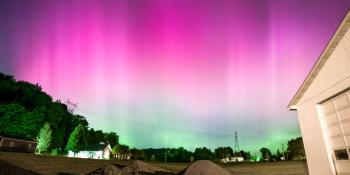Affichage des archives de mercredi, 2 mars 2011
Rapport d'activité solaire
Any mentioned solar flare in this report has a scaling factor applied by the Space Weather Prediction Center (SWPC). Because of the SWPC scaling factor, solar flares are reported as 42% smaller than for the science quality data. The scaling factor has been removed from our archived solar flare data to reflect the true physical units.
Rapport d'activité solaire et géophysique 2011 Mar 02 2200 UTCFait par le NOAA © SWPC et adapté par SpaceWeatherLive.com
Rapport de l'USAF/NOAA sur l'activité solaire et géophysique
SDF numéro 061 publié à 2200Z le 02 Mar 2011IA. Analyse des régions solaires actives et activité du 01-2100Z au 02-2100Z Solar activity was low. Region 1164 (N25E08) produced
a C1/Sf x-ray flare at 02/1318Z, the only flare of significance
during the period. Region 1164 decreased in area, but remained an
Ekc type spot group with Beta-Gamma-Delta magnetic characteristics.
New Region 1166 (N10E77) rotated onto the disk as an Hsx type spot
group with Alpha magnetic characteristics. A flux region emerged in
the northeast quadrant near N20E40.
IB. Prévisions d'activité solaire
Solar activity is expected to be low
for the next three days (03-05 March), however a chance exists for
an M-class event from Region 1164.
IIA. Résumé de l'activité géophysique du 01-2100Z au 02-2100Z
The geomagnetic field was at active to minor storm levels for the
first 12 hours of the period and at quiet to unsettled levels for
the remainder. A recurrent coronal hole high speed stream remains
geoeffective. Solar wind speed at the ACE spacecraft remained
elevated at 640 km/s. The Bz component of the interplanetary
magnetic field began the period near -10 nT but slowly returned to
near neutral values by the end of the period. The greater than 2 MeV
electron flux at geosynchronous orbit reached high levels during the
period.
IIB. Prévision de l'activité géophysique
The geomagnetic field is
expected to be unsettled to occasionally active for the next three
days (03-05 March) due to the continued influence of the coronal
hole high speed stream.
III. Probabilité d'éruption solaire du 03 Mar au 05 Mar
| Classe M | 35% | 35% | 35% |
| Classe X | 05% | 05% | 05% |
| Proton | 05% | 05% | 05% |
| PCAF | Green | ||
IV. Flux Penticton 10.7 cm
Observé 02 Mar 113 Prévisionnel 03 Mar-05 Mar 115/120/120 Moyenne des 90 derniers jours 02 Mar 088
V. Indice géomagnetique A
Observé Afr/Ap 01 Mar 018/031 Estimé Afr/Ap 02 Mar 015/017 Prévisionnel Afr/Ap 03 Mar-05 Mar 015/015-012/012-010/010
VI. Probabilités d'activité géomagnétique du 03 Mar au 05 Mar
| A. Latitudes moyennes | |||
|---|---|---|---|
| Actif | 30% | 25% | 20% |
| Tempête mineure | 15% | 10% | 05% |
| Tempête majeure/sévère | 01% | 01% | 01% |
| B. Hautes latitudes | |||
|---|---|---|---|
| Actif | 40% | 25% | 25% |
| Tempête mineure | 15% | 15% | 15% |
| Tempête majeure/sévère | 10% | 05% | 05% |
Toutes les heures sont indiquées en UTC
Dernières nouvelles
Forum
Latest SC25 Predictions 132Red Auroras 18Incoming Active Regions 378AR3664 1105A little bit about our hobby for the general public 7
Plus de messages du forumAidez SpaceWeatherLive.com !
Vous êtes de plus en plus nombreux à consulter SpaceWeatherLive pour suivre l'activité solaire ou aurorale, et avec le traffic les coûts du serveur augmentent. Si vous appréciez SpaceWeatherLive, soutenez notre projet en faisant un don afin que nous puissions continuer à vous informer !

La Météo Spatiale en faits
| Dernière classe X | 15/05/2024 | X2.9 |
| Dernière classe M | 19/05/2024 | M1.6 |
| Dernier orage géomagnétique | 17/05/2024 | Kp6 (G2) |
| Jours sans taches solaires | |
|---|---|
| Dernier jour sans taches solaires | 08/06/2022 |
| Nombre mensuel moyen de taches solaires | |
|---|---|
| avril 2024 | 136.5 +31.6 |
| mai 2024 | 155.9 +19.4 |
| Last 30 days | 163.2 +40.8 |


